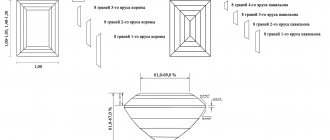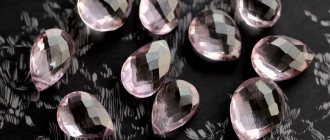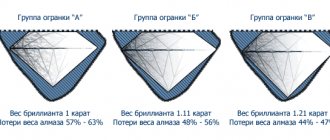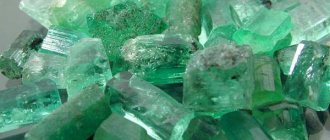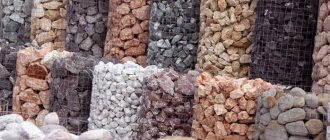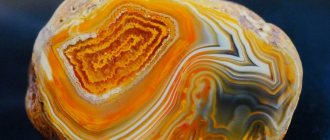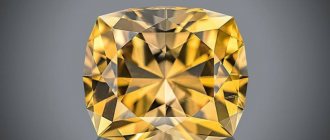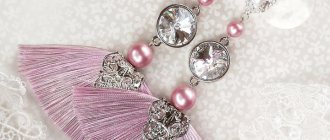August 31, 2021
The form of cutting stones in jewelry is an entire art, the development of which dates back several thousand years. Even ancient masters of fine crafts sought to turn found gems into something special, trying to give them intricate shapes. But it was only by the middle of the 19th century that the first cutting machines with tools of the necessary hardness appeared, which made it possible to create inlays for jewelry in the form as we know them today.
In this material we will tell you what types of cutting gemstones there are, how common shapes affect the refraction of light, and what jewelry with inlays can be bought in the Love Line online store at the most affordable prices.
Circle
It is ironic that the most sought-after cut on the market, the perfect circle, is one of the most difficult to execute, since it was originally invented for diamonds, which until around the 16th century remained minimally processed in earrings or rings. Today, the “royal standard” is considered to be a circle façade of 57 facets, regardless of the weight of the gem, although smaller exceptions are possible for very tiny stones.
The history of the creation of the Octagon cut
Modern standards for the Octagon cut were adopted in the 1940s - initially this cut was intended specifically for emeralds, but over time, sapphires, tourmalines, beryls, and other stones began to be cut in this way. High purity and transparency of the stone is required, otherwise imperfections will be visible to the naked eye. Light hitting the surface is reflected in wide and bright flashes. In terms of cost and complexity, this is one of the most affordable cuts.
View all jewelry from the IN COLOR collection in the SUNLIGHT catalog
Oval
With the advancement of technology and the advent of electric machines in the mid-20th century, the improved oval cut was born. She didn't just add a wedge-shaped fin surface that maximizes light refraction from the surface of the crystal. Thanks to the elongated texture, precious rings with such an insert visually lengthen the fingers, and pendants or earrings are so impressive that they are guaranteed to attract all the attention.
What stones are suitable
Cutting is used when processing fancy diamonds of the highest quality, large emeralds without a large number of inclusions and other fragile colored minerals from the beryl group. The technology is not used when working with low-quality gems; it makes the smallest defects (microcracks, inclusions) visible.
Products with octagon-shaped gems are included in the latest collections of domestic and foreign jewelry brands. Step cutting preserves the integrity of the natural crystal, emphasizing its color and purity. The technology is used when working with different gems:
- Swiss blue topaz;
- emeralds;
- rubies;
- sapphires;
- aquamarines;
- rare morganites.
The large top platform visually enlarges the crystal, so rings with rectangular shaped inserts lengthen the fingers
Emerald-cut crystals are inlaid into jewelry in composition with other gems or used individually.
Square
A fairly ancient technique that has become popular due to its simplicity and natural grace of parallel lines. To be completely precise, the crystal turns out to be square only in the main section - in fact, it is a truncated pyramid. For such an insert to look respectable, blanks weighing 1 carat or more are required, which is why the form has become most popular with semi-precious gems.
Stone processing techniques
There are two main types of cuts:
- manual,
- machine.
Cutting of jewelry inserts is usually done by hand. Masters create unique jewelry and their prices are appropriate.
Machine cutting is used for transparent and translucent stones. Light rays hit the crystal and are refracted at its edges.
There are four processing schemes in total:
- wedge - the stone reflects light best;
- faceted - the height of the cut depends on the color of the mineral: the darker it is, the greater the number of facets;
- Russian - removal of all unnecessary parts of the stone;
- combined - combines techniques of all types of cutting.
Emerald
A rectangle with octagonal beveled edges - from 3 to 6 on each side - is an ideal shape for emeralds and any jewelry where the green gem is used as the dominant insert. The only requirement for the stone is that it must be of maximum purity, without internal cracks, darkening and traces of obvious laboratory refining, because the entire interior will be visible in the light.
Purpose of cutting
Cutting precious and semi-precious stones is a painstaking and time-consuming job. The main task of a jeweler is to obtain a perfect crystal from a nondescript piece of rock. To create a flawless stone, you must achieve the following goals:
- Use the edges to maximize the play of light.
- Maintain or increase color depth.
- Create the perfect shape.
It is possible to achieve the set goals only when the physical properties of a particular mineral are taken into account - hardness, fragility, purity, optical properties. These points influence the choice of cutting method, number of facets, emphasis on color preservation or the original mass of the nugget.
Baguette
The ancestor of the emerald appeared exactly one hundred years ago, when, after the First World War, the Art Deco style emerged in European culture, which became a hymn to geometric minimalism. The style, on the one hand, resembles the famous bakery product, and on the other, it is a kind of picture frame in miniature - it is not surprising that in a professional environment they are also called baguettes. The cut is good for men's signets and women's jewelry of a strict style.
Marquis
This is the name of a variant of processing gems, which is based on an elongated rhombus with rounded outer edges, or, in simple terms, a boat. The lines must be connected according to a mathematically calculated formula so that the distance between opposite edges divides the entire figure into two identical halves. The number of edges can be impressive - from a “modest” 33 to the Royal category of 55 intersecting lines.
Interesting fact: It is believed that the cutting technique received its unusual name thanks to the Marquise de Pompadour, the legendary mistress of the French king Louis XV. In order to please the capricious favorite, the ruler ordered the court jewelers to create a stone with perfectly symmetrical lines that would emphasize the lady’s graceful smile.
Jewelry terminology
Before assessing the quality of the cut, you need to know some of the terms that craftsmen use when performing this type of processing of gems.
To enlarge the diagram, click on it.
Cutting a mineral involves dividing the material into the following zones:
- The platform or facet is the largest facet of the stone, the top flat base. The width of the pad is measured as a percentage of the total width of the nugget.
- The pavilion is the lower part of the stone.
- The girdle is the line separating the pavilion from the top of the gem. This boundary defines the perimeter of the stone. The girdle serves as a place for securing the faceted mineral in the setting of the product.
- The crown is the upper part of the stone, located above the girdle and surrounding the platform.
- The culet is the lowest point of a faceted nugget. Occasionally, a callet, as a cut element, is missing. Sometimes the absence of this part indicates damage to the mineral.
The cut edges are also called bevels. Depending on the type of cut, up to 240 facets are applied to one crystal. Each edge must be perfectly smooth and located at a specific angle. If the proportions are respected, it is ultimately possible to fully reveal the beauty of the mineral.
Cabochon
It is not entirely correct to classify cabochons as a type of cut, because essentially this is a method of grinding and polishing a jewelry stone, which gives it the shape of a ball or hemisphere with a flat base. Almost all pearl jewelry uses this method to hide the natural imperfections of the pearl pea. For the same purposes, cat's eye, onyx, black agate and other fragile opaque gems that do not require edges are made into cabochons.
Interesting facts about the types of cuts and shapes of stones
Dear friends! I found in my drafts materials on the types of cuts and shapes of stones, this topic interested me and I decided to share my little “research” with you.
Cut is important for any stone except pearls.
One of the important aspects of gemstone evaluation is learning how to look at the stone, even if you can't do it as a gemologist.
When it comes to cut stones, it is important to know a certain number of terms used in this field. The elements of the stone can vary in their proportions, and this affects the shine, appearance and attractiveness accordingly.
Let's start with terminology and understanding what stands behind the words, especially those that characterize the cutting of a stone. So:
Girdle. A girdle is the edge or tip of a stone that forms its perimeter. This is the end where the upper and lower parts of the stone meet, that is, in fact, a kind of dividing line. This is where the frame is usually fixed.
Crown. The crown is the upper part of the stone located above the girdle.
Pavilion. The pavilion is the lower part of the stone, in other words, that part of the stone that is located below the girdle down to its lowest point.
Kaleta. The kaleta is the lowest point of the stone. When examining a number of stones, you may not see it, which probably indicates a possible defect, but with regard to colored stones, a question may arise about the design of the cut.
Platform (or table). This is the flat top face of the stone, and it is also its largest face, sometimes called the face.
The term "plate size" is used to describe the width of this facet, which is often expressed as a percentage of the total width of the stone. TYPES OF CUT
The beauty of a gemstone is determined by its color and optical properties, which are revealed as a result of cutting and polishing.
Let's look at the types of cuts.
Cabochon is one of the most ancient cutting methods, which involves giving the stone a round shape. This type of cut is suitable for almost all stones, and especially for stones with optical effects.
Facet cut is a grinding and cutting process that involves many small facets. Facet cutting can be diamond or step.
Full brilliant cut - no less than 32 facets on the top and no less than 24 facets on the bottom.
Brilliant cut - there are several types. The most common are “ eight ” and “ rose ”.
The “eight” cut has, in addition to the platform, 8 facets in the upper and lower parts. It is used for processing small stones, the complete cutting of which is impossible.
“Rose” is a cut without a platform and a lower part. There are several options depending on the number and location of facets (Dutch, half-Dutch, cross, briolette, etc.). However, jewelers claim that “rose” gives poor play to the stone, so this cut is used on stones with defects.
Step cutting (ladder cutting) is used for colored, transparent stones. Most of the facets have parallel edges, the steepness of the facets and the directions towards the girdle (the rim separating the upper and lower parts of the stone) increases. The number of facets in the lower part is usually greater than in the upper part. This cut allows you to highlight the inner color of the stone.
Wedge cut is a type of step cut in which each facet is divided into four wedges.
The Ceylon cut makes it possible to preserve the weight of the stone as much as possible: many small facets are applied to the gem.
The emerald step cut is used for the octagonal shape of the stone, and is mainly used for processing emeralds. The Ural emerald cut is considered the most recognized in the world.
The table cut is a simple type of step cut. To increase the platform (tablet), the top part of the stone is made flat. Used for men's rings, especially signets.
STONE SHAPES With the same type of grinding, stones can be given various shapes: ball, oval, cone, antique (square or rectangle with rounded corners and gently convex sides), triangle, square (square), hexagon, baguette (elongated rectangle), trapezoid, French cut (general contour and platform are square, triangular facets), drop (pear-shaped), shuttle or marquise (pointed ellipse), pendant (elongated teardrop-shaped), briolette (pear-shaped with intersecting facet ribbons), olive (narrow, barrel-shaped) . Many fantasy forms are also known: heart, coat of arms, etc.
Here are examples of some of the stone shapes.
Antique shape.
Baguette shape. By the way, this is my favorite cut. In my opinion, she is very noble.
A very popular form is “briolette”.
Princess shape of the stone. The Princess cut is a modern classic with clean, square lines and beautiful sparkle. This shape is a great choice if you prefer square or rectangular shapes but want the same sparkle as a round diamond cut. Developed in the 1970s, the Princess cut is second in popularity only to the round cut. This form of stone cut combines the step cut of an emerald with the triangular cut of a diamond and is a square cut. Although a square cut shape is most preferred, some stones may have more of a rectangular outline. A princess cut stone looks beautiful either alone in a ring or framed by other stones, especially trillions and smaller diamonds cut in a princess shape.
The octagon cut shape is “octagonal”.
Marquise shape. The Marquise cut is a royal, elongated shape of the stone that tapers at both ends. When choosing a marquise cut shape, it is necessary to take into account the ratio of length and width. A 2:1 ratio is usually preferred, meaning that the length of the stone should be twice its width. A Marquise-cut diamond must be reinforced with six prongs: four on the sides to securely hold the stone itself and two V-shaped prongs on each end, which are the most vulnerable parts of the diamond.
Exquisite triangular shape - "trillion". Trillion is a spectacular wedge cut. First developed in Amsterdam, cut designs can vary depending on the natural characteristics of the stone and the personal preferences of the cutter. It can be either a traditional triangular shape with sharp corners or a more rounded shape.
The external shape affects the overall attractiveness of the stone, but with a high-quality cut this is unimportant. For the average consumer, shape is simply a matter of personal preference.
This jewelry uses six types of stone cuts.
And here are photographs of very beautiful jewelry with natural stones of various shapes and types of cuts.
Ending my publication with a photograph of a heart, I really hope that you liked this article, learned something new, or simply had a soulful time contemplating the beautiful creations of nature and human hands.
I wish you all the best!
Sincerely, Your Mrs. Nina
Pear
It is also a drop, which arose as a development of the round style. Jewelers joke that the pear-shaped cut appeared as a result of a million damaged blanks in the form of a circle. It is distinguished by harmonious central symmetry and beveled facets in the form of wedges. Thanks to this combination, even a tiny insert will have a shine that will be the envy of massive crystals, and in pendants, pendants or long earrings it looks especially elegant and rich.
Trillion
The youngest method of processing natural gems has not even celebrated its 40th anniversary - it was patented by an Amsterdam jewelry house in the mid-80s. As you might guess, the prefix three- in the word trillion means the texture of a triangle, along which the edges are alternately applied. They can be equilateral or isosceles, the main thing is to ensure the refraction of light and disintegration into that same priceless rainbow spectrum.
Princess
The princess cut is a “pumped up” version of a square with at least 16 edges, and they can be located both from the center and from the edges of the outer contour. Its highlight is the mirror symmetry of the corners, which can create a cross-shaped or star-shaped reflection. There are practical advantages - no matter how complex the master jeweler’s idea may be, the specific arrangement of the facets can significantly save the amount of stone removed.
Interesting fact: It was the princess that formed the basis of the most commercially successful Tiffany cut, which since the middle of the last century has become the international standard for engagement rings. According to the American brand, a diamond in such jewelry must have at least 50 facets that can shimmer at the slightest movement of a woman’s hand.
Octagon cut engagement rings
A geometrically precise, refined Octagon cut shape for a diamond set in a ring will highlight the beauty of aristocratically elongated fingers and will do a good job of visually lengthening the lines of their hands. An Octagon-cut diamond will show its “game” to a lesser extent, but will appear in all the splendor of light, flashing with wide and bright flashes. A fairly open cut has another feature that must be taken into account when choosing a stone - it demonstrates its slightest flaws with immediate sincerity, so the clarity and quality of the cut of a diamond framed in the shape of an oblong stepped octagon must be at its best.
View all rings with Octagon-cut stones in the SUNLIGHT catalog
Donald Trump gave his wife Melania a ring with an impressive 15-carat Octagon-cut diamond. Melania loves this decoration very much and always tries to show it off, as if inadvertently, whether by brushing her bangs off her forehead or posing for photographers with her hand on her hip.
Melania Trump's Octagon-cut diamond engagement ring
Amal Alamuddin received the coveted platinum ring with an Octagon-shaped diamond weighing seven carats as a gift from George Clooney. A diamond of incredible clarity is paired with a platinum ring, symbolizing purity squared. The Octagon-shaped cut diamond is surrounded by smaller diamonds.
Amal Alamuddin Octagon Cut Diamond Engagement Ring
Angelina Jolie's engagement ring from jeweler Robert Prokop, given to her by Brad Pitt, features a 16-carat super-quality Octagon-cut white diamond with smaller baguette-cut diamonds throughout the ring. Unlike Melania Trump, Angelina Jolie and Amal Alamuddin do not often wear their precious rings, believing that with their multifaceted sparkle such conspicuous jewelry discredits them in everyday work, and this is also a feature of the emerald cut - thanks to it the stone looks large, it is difficult not to notice.
Angelina Jolie's Octagon-cut diamond engagement ring
Heart
Perhaps the most original and romantic of all forms, because the heart is an internationally recognized symbol of love and reverent feelings for a person. It is not simple, according to the classical standard it has at least 57 edges, hence the excessive requirements for the mass of the workpiece. However, it is “heart” inserts that are most often used in exclusive designer products - the exquisite, unique result is worth any effort.
Cushion
The final form of jewelry cut in our rating is cushion or old mine cut, as Western manufacturers call it. It is considered the classic and most complex diamond technique with 57 facets, 33 of which crown the top half. Any base is allowed - a circle, an ellipse, an oval or a rounded square, the main thing is to demonstrate the aristocratic style on the most expensive gem.
Of course, this is not a complete list of styles for those who are interested in what types of stone cuts there are. In addition to the 12 main forms, there are patented processing methods - jewelry giants such as Swarovski or Tiffany jealously guard their ideas, not allowing other manufacturers to use a style that is recognizable throughout the world.
Well, the Love Line online store guarantees that any jewelry with a precious stone from the catalog will delight you and your loved ones with a variety of shapes, colors and styles.
Share
Antique Octagon Cut Jewelry
Elizabeth Taylor's emerald set from the BVLGARI jewelry house is a gift from Richard Burton, made between 1962 and 1967. Collected over a series of trips to the BVLGARI boutique on Via Condotti in Rome, the jewelry that created the incredible set was a favorite reminder of the filming of Cleopatra. Richard Burton quipped about his time with Elizabeth in Rome: “I introduced Liz to beer, and she introduced me to BVLGARI.”
Elizabeth Taylor emerald set from the BVLGARI jewelry house
The 33.19-carat diamond ring was a gift from Richard Burton on May 16, 1968. Considered one of the most iconic of the actress's favorite clear diamonds, this spectacular stone was an integral part of Elizabeth Taylor's life and graced her finger almost every day.
The great actress said: “My ring brings me the most amazing feeling of beauty. His sparkles of red and white and blue and purple and so on are like the noise of his own divine life.”
Octagon-cut diamond ring weighing 33.19 carats
One of the most daring designs from the English royal treasury is the tiara, which is crowned with a tall Octagon-cut aquamarine. The jewelry is decorated with large quadrangular aquamarines surrounded by small diamonds. This Brazilian aquamarine tiara is a favorite of the Queen's valet Angela Kelly, who describes it as "stately yet cool and calming."
Tiara with Brazilian aquamarines from the English royal treasury
